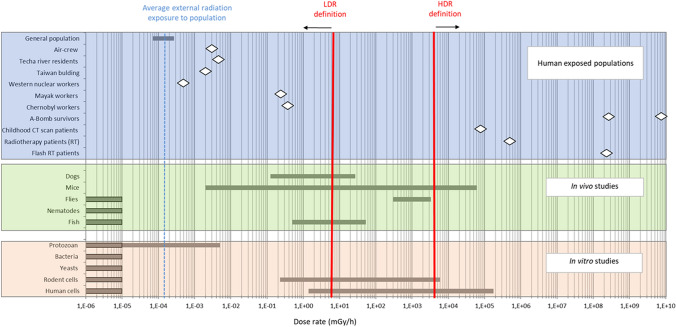Fig. 1.
Representation of dose rate ranges (log scale in mGy/h) considered by the different studies presented separately for human, in vivo and in vitro studies. The range of external dose rates received in the general population is shown along with the average 2.4 mGy/h exposure rate worldwide (blue dashed line) (UNSCEAR 2000). LDR definition corresponds to 5 mGy/h and HDR to 0.05 Gy/min (solid red lines). For epidemiological studies, average dose rates in specific situations are shown and represent radiation exposure above background (white diamonds). In comparison, dose rates from the LSS (given in terms of free-in-air kerma) are large and of the order of 1.9 × 108 mGy/h–8.6 × 109 mGy/h, for atomic-bomb survivors located at 2000 m and 1000 m distance from the Hiroshima hypocentre at time of the incident, respectively (for details, see text). For medical exposure situations, average dose rates to the tumours have been considered for radiotherapy and to the area of the body explored for CT-scan. Note that for exposures of atomic-bomb survivors and patients due to diagnostic and therapeutic procedures, times of exposure are short and, therefore, dose rates given in terms of mGy/h may be misleading. For in vivo and in vitro studies, a range is shown that is representative of the dose rates used in selected publications discussed. Data from experiments carried out in Deep Underground Laboratories (DULs) are also reported (grey bars between 1 × 10–6 and 1 × 10–5 mGy/h)

